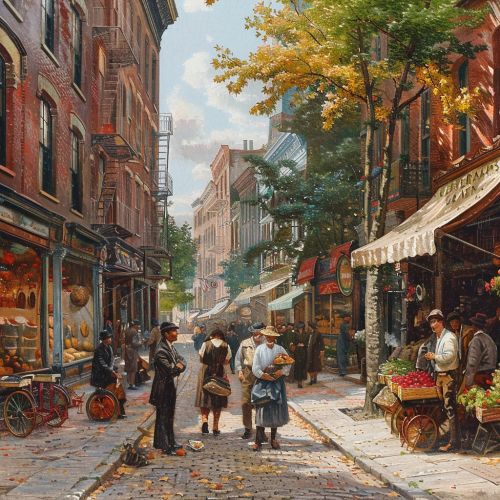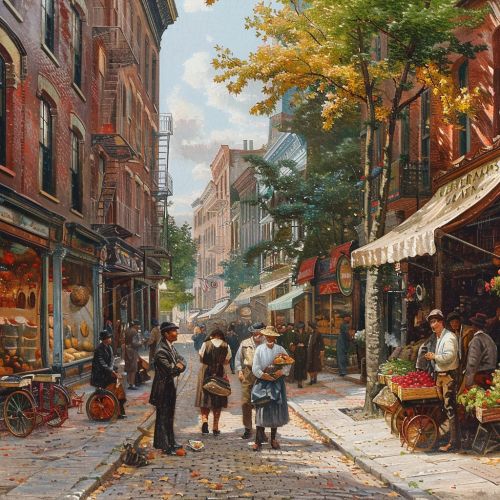Literary realism: Difference between revisions
(Created page with "== Literary Realism == <div class='only_on_desktop image-preview'><div class='image-preview-loader'></div></div><div class='only_on_mobile image-preview'><div class='image-preview-loader'></div></div> === Introduction === Literary realism is a movement that emerged in the mid-19th century as a reaction against the romanticism and idealism of previous literary traditions. It aims to depict everyday life and society with a high degree of fidelity, focusing on ordinary ch...") |
No edit summary |
||
| Line 1: | Line 1: | ||
== Literary Realism == | == Literary Realism == | ||
[[Image:Detail-97229.jpg|thumb|center|19th century street scene depicting everyday life.|class=only_on_mobile]] | |||
[[Image:Detail-97230.jpg|thumb|center|19th century street scene depicting everyday life.|class=only_on_desktop]] | |||
=== Introduction === | === Introduction === | ||
Latest revision as of 20:38, 26 July 2024
Literary Realism


Introduction
Literary realism is a movement that emerged in the mid-19th century as a reaction against the romanticism and idealism of previous literary traditions. It aims to depict everyday life and society with a high degree of fidelity, focusing on ordinary characters and plausible events. The movement is characterized by its detailed descriptions, complex characters, and emphasis on social issues. Literary realism seeks to represent the world as it is, without embellishment or idealization, and often addresses the socio-political conditions of the time.
Historical Context
The rise of literary realism coincided with significant social, political, and economic changes in Europe and America. The Industrial Revolution, urbanization, and the rise of the middle class created a new social landscape that demanded a different literary approach. Realism emerged as a response to these changes, offering a more accurate and unvarnished portrayal of contemporary life.
The movement began in France with authors such as Honoré de Balzac and Gustave Flaubert, who sought to depict the complexities of modern society. It quickly spread to other countries, influencing writers like Charles Dickens in England, Fyodor Dostoevsky in Russia, and Mark Twain in the United States.
Characteristics
Literary realism is defined by several key characteristics:
Detailed Descriptions
Realist authors employ meticulous detail to create a vivid and accurate representation of the world. This includes descriptions of settings, objects, and everyday activities. The goal is to immerse the reader in the environment and make the narrative as believable as possible.
Complex Characters
Unlike the often idealized or exaggerated characters of romantic literature, realist characters are complex and multifaceted. They possess a mix of virtues and flaws, making them more relatable and human. Realist authors delve into the psychological depth of their characters, exploring their motivations, desires, and internal conflicts.
Social Issues
Realist literature frequently addresses social issues such as class disparity, gender roles, and the impact of industrialization. Authors use their works to critique societal norms and highlight the struggles of ordinary people. This focus on social issues reflects the movement's commitment to portraying life as it is, including its injustices and inequalities.
Plausible Events
The events in realist literature are grounded in reality and are often drawn from everyday life. Unlike the fantastical plots of romantic literature, realist narratives are plausible and reflect the experiences of ordinary people. This emphasis on plausibility enhances the authenticity of the narrative.
Major Authors and Works
Several authors are central to the literary realism movement, each contributing unique perspectives and styles.
Honoré de Balzac
Balzac's "La Comédie Humaine" is a monumental series of interconnected novels and stories that depict French society in the early 19th century. His detailed descriptions and complex characters set the standard for realist literature.
Gustave Flaubert
Flaubert's "Madame Bovary" is a seminal work of literary realism. The novel's meticulous detail and unflinching portrayal of its protagonist's life exemplify the movement's principles. Flaubert's commitment to depicting reality without moral judgment was groundbreaking.
Charles Dickens
Dickens is known for his vivid depictions of Victorian England and his critique of social injustices. Works like "Bleak House" and "Great Expectations" combine detailed descriptions with complex characters to highlight the struggles of the poor and marginalized.
Fyodor Dostoevsky
Dostoevsky's novels, such as "Crime and Punishment" and "The Brothers Karamazov," explore the psychological depth of his characters and address profound social and philosophical issues. His work is characterized by its intense focus on the human condition.
Mark Twain
Twain's "The Adventures of Huckleberry Finn" is a cornerstone of American realism. The novel's use of vernacular language and its portrayal of life along the Mississippi River provide a vivid and authentic depiction of American society.
Influence and Legacy
The influence of literary realism extends beyond the 19th century, shaping modern literature and other artistic forms. The movement's emphasis on detailed description, complex characters, and social issues has left a lasting impact on how stories are told.
Naturalism
Naturalism, an offshoot of realism, takes the principles of the movement further by emphasizing determinism and the influence of environment and heredity on human behavior. Authors like Émile Zola and Theodore Dreiser are key figures in this subgenre.
Modernism
While modernism represents a departure from realism in many ways, it retains the realist commitment to depicting reality. Modernist authors like James Joyce and Virginia Woolf employ stream-of-consciousness techniques to explore the inner lives of their characters, reflecting a continued interest in psychological depth.
Contemporary Literature
Contemporary literature continues to be influenced by the principles of realism. Authors like Jonathan Franzen and Zadie Smith incorporate detailed descriptions and complex characters in their works, addressing contemporary social issues in the process.
Criticism
While literary realism has been praised for its fidelity to life and its social critique, it has also faced criticism. Some argue that the movement's focus on the mundane can lead to a lack of narrative excitement. Others contend that realism's commitment to depicting reality can result in a deterministic view of human life, limiting the scope for individual agency and imagination.
Conclusion
Literary realism represents a significant shift in the history of literature, moving away from the idealized and fantastical to focus on the ordinary and the real. Its emphasis on detailed descriptions, complex characters, and social issues has had a profound and lasting impact on literature and other forms of art. By portraying life as it is, realist authors have provided readers with a deeper understanding of the human condition and the society in which they live.
